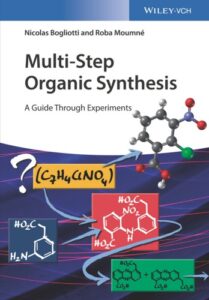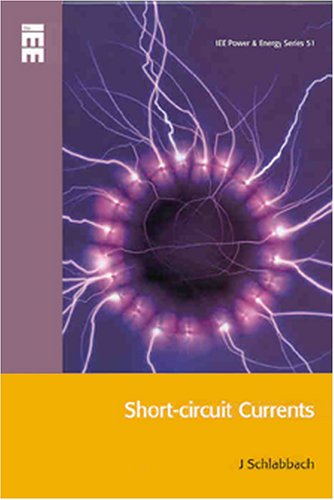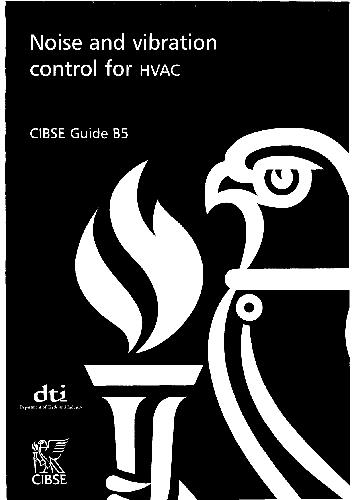| Book Name: | Multi-Step Organic Synthesis A Guide Through Experiments |
| Language: | English |
| Format: | |
| Free Download: | Available |
Multi-Step Organic Synthesis A Guide Through Experiments by Nicolas Bogliotti and Roba Moumne | PDF Free Download.
| Book Details : | |
|---|---|
| Language | English |
| Pages | 282 |
| Format | |
| Size | 21.1 MB |
Multi-Step Organic Synthesis A Guide Through Experiments

Multi-Step Organic Synthesis Contents
- Atovaquone: An Antipneumocystic Agent
- SEN794: An SMO Receptor Antagonist
- Synthesis of an H1–H3 Antagonist
- Synthesis of Eletriptan
- Total Synthesis and Structure Revision of Streptophenazine A
- Synthesis of Leiodermatolide, A Biologically Active Macrolide
- Azobenzene-Thiourea Catalysts for the Control of Chemical Reactivity with Light
- Synthesis and Properties of a Photo-activatable Mimic of Pyridoxal
- Fluorescent Peptides for Monitoring Activity of Autophagy-Initiating Enzyme
- Fluorescent Peptide Probes for Cathepsin B
- Total Synthesis of Stemoamide
- Total Synthesis and Structure Revision of Caraphenol B
- Synthetic Routes Toward Muricatacin and Analogs
- Asymmetric Synthesis of (−)-Martinellic Acid
- Cyclic Pseudopeptides as Potent Integrin Antagonists
- Enantioselective Synthesis of Non-natural Amino Acids for Incorporation in Antimicrobial Peptides
Preface to Multi-Step Organic Synthesis A Guide Through Experiments
This book is a collection of problems in organic chemistry finding its origin between 2010 and 2015 at École normale supérieure Paris‐Saclay (at that time École normale supérieure de Cachan).
In the context of students’ preparation for a competitive national examination in Chemistry (Agrégation de Sciences Physiques, option Chimie), giving access to teaching positions in French higher education institutions, a number of exercises dealing with multistep syntheses of natural products and active pharmaceutical ingredients were created from the chemical research literature.
After extensive selection, adjustment, and modification, part of the original material is compiled in this volume. It is completed by exercises related to the field of chemical biology, which we consider an essential branch of chemical education, taught at Université Pierre et Marie Curie.
Besides its initial purpose, this work reflects some extent a common practice in organic chemistry research laboratories, often on the occasion of group seminars, which is going through multistep synthesis with questions related to synthetic strategies, reaction conditions, and transformation mechanisms.
In this respect, several excellent titles are available and listed in the “Further Reading.” While we tried to inject some of this essence in our book, our objective was also to provide a broad readership, not necessarily specialized in organic chemistry,
And an accessible set of problems in multistep synthesis, including experimental aspects, which are not extensively covered by current offers available on the market.
The “self‐studying” nature of this book indeed allows the reader to be assisted by a number of indications such as the detailed textual description of the operating conditions (rate and order of reagents addition), macroscopic observations (color change, gas evolution, the formation of a precipitate, increase in temperature, etc.),
Workup procedures (neutralization, extraction, etc.), as well as selected characteristic spectroscopic or spectrometric data of the products (infrared vibrations, 1 H‐NMR, and 13C‐NMR, mass spectrometry, etc.).
Elucidation of molecular structure is thereby seen as a puzzle to be solved by aggregating available pieces.
This vision of chemistry as essentially a game and a source of intellectual stimulation, shared by many of our colleagues, is worth putting forward, especially in the troubled times when “societal impact” tend to constitute the quasi‐ exclusive input and justification for scientific research.
We stress that our book aims to be a practicing medium adapted from published syntheses, not a strictly authentic description thereof.
Indeed we chose to favor pedagogy over authenticity when we estimated that part of the original research article was not completely suited for teaching purposes.
For example, while we enforced to keep intact the “spirit” of the initial work, we also took the freedom to slightly modify reaction conditions or synthetic routes and add expected characteristic spectroscopic data when missing in the original article, in order to create a story which, although not entirely real, remains mostly plausible.
These modifications are listed as footnotes throughout the book. As teachers, we see such a choice as a requirement to render state‐of‐the‐art syntheses overall accessible to nonexperts; while as researchers, we are convinced that students need to be in contact as early as possible with the practice of chemistry as it is performed in research laboratories.
In the first part, Chapters 1–5 describe short syntheses, with the longest linear sequences below five steps, which are well suited to emphasize the understanding of operating conditions and workup procedures.
Process‐scale syntheses of active pharmaceutical ingredients are especially represented, shedding light on common practices of the chemical industry that are often unknown (or unsuitable) to academic laboratories.
Then, Chapter 6, presenting the total synthesis of a complex biologically active macrolide, might appear as uncommon in the sense that only a few chemical structures are mentioned (mostly starting materials, by‐products, and target compounds).
Rather, a number of indications are given in a textual form. Such a presentation, which somehow parallels the ability of some chemists to precisely define complex molecular structure by merely employing appropriate words, undoubtedly requires effort to maintain a sufficient level of mental representation.
Chapters 7–10 deal with the synthesis of photochromic and fluorescent molecules, whose properties either allow the control of reactivity with light or the monitoring of enzyme activity in a biological context.
Some general aspects of structure-property relation are included. Chapters 11–14 report synthetic approaches toward various natural products.
Although slightly more “classical” in their form, as compared to other problems in the book, they highlight the detours, surprises, and dead ends commonly faced in total synthesis.
Finally, given the growing interest for education at the chemistry/biology interface and the key role played by chemists in understanding living systems at the molecular scale,
Chapters 15 and 16 are dedicated to the chemical synthesis of relevant bioactive compounds and the study of their biological activities, with emphasis on the relation between tridimensional structure and function.
We express our warmest thanks to the reader paying attention to this book and our words, and also to our past and present students, colleagues, and mentors, for their input on this work.
Multi-Step Organic Synthesis A Guide Through Experiments
Author(s): Nicolas Bogliotti, Roba Moumné
Publisher: Wiley-VCH, Year: 2017
ISBN: 3527340653, 978-3527340651
Download Multi-Step Organic Synthesis A Guide Through Experiments in PDF Format For Free.
Related More Books
See More POST On : Engineering Books









![[PDF] Draw Buildings and Cities in 15 Minutes Draw Buildings and Cities in 15 Minutes pdf](https://www.freepdfbook.com/wp-content/uploads/2021/06/Draw-Buildings-and-Cities-in-15-Minutes-218x150.jpg)








![[PDF] Digital Image Processing An Algorithmic Introduction Using Java Digital Image Processing An Algorithmic Introduction Using Java](https://www.freepdfbook.com/wp-content/uploads/2022/06/Digital-Image-Processing-An-Algorithmic-Introduction-Using-Java.jpg)




![[PDF] 43 Years JEE ADVANCED + JEE MAIN Chapterwise & Topicwise Solved Papers 43 Years JEE ADVANCED (1978-2020) + JEE MAIN Chapterwise & Topicwise Solved Papers Physics PDF](https://www.freepdfbook.com/wp-content/uploads/2022/03/43-Years-JEE-ADVANCED-1978-2020.jpg)

![[PDF] Problems in Physical Chemistry for JEE (Main & Advanced) Problems in Physical Chemistry for JEE (Main & Advanced) Free PDF Book Download](https://www.freepdfbook.com/wp-content/uploads/2022/03/Problems-in-Physical-Chemistry-for-JEE-Main-Advanced.jpg)
![[PDF] Engineering Physics (McGraw Hill)](https://www.freepdfbook.com/wp-content/uploads/2021/05/bafc8c2685bb6823a9c56134f7fba5df.jpeg)

![[PDF] Engineering Chemistry By Shashi Chawla](https://www.freepdfbook.com/wp-content/uploads/2022/05/Theory-And-Practicals-of-Engineering-Chemistry-By-Shashi-Chawla-free-pdf-book.jpeg)
![[PDF] Chemistry: An Introduction to Organic, Inorganic & Physical Chemistry Chemistry: An Introduction to Organic, Inorganic & Physical Chemistry](https://www.freepdfbook.com/wp-content/uploads/2022/04/Chemistry-An-Introduction-to-Organic-Inorganic-Physical-Chemistry.jpg)
![[PDF] Essentials of Physical Chemistry Essentials of Physical Chemistry Free PDF Book by Bahl](https://www.freepdfbook.com/wp-content/uploads/2022/04/Essentials-of-Physical-Chemistry-bahl.jpg)
![[PDF] Biological control of plant-parasitic nematodes: soil ecosystem management in sustainable agriculture Biological control of plant-parasitic nematodes: soil ecosystem management in sustainable agriculture](https://www.freepdfbook.com/wp-content/uploads/2022/05/Biological-control-of-plant-parasitic-nematodes-soil-ecosystem-management-in-sustainable-agriculture.jpg)
![[PDF] Human Anatomy: Color Atlas and Textbook Human Anatomy: Color Atlas and Textbook Free PDF Book](https://www.freepdfbook.com/wp-content/uploads/2022/05/Human-Anatomy-Color-Atlas-and-Textbook.jpg)
![[PDF] Concepts of Biology Book [Free Download]](https://www.freepdfbook.com/wp-content/uploads/2022/05/Concepts-of-Biology.jpg)
![[PDF] Essentials of Biology [Free Download] Essentials of Biology Free PDF BOok Download](https://www.freepdfbook.com/wp-content/uploads/2022/05/Essentials-of-Biology-Free-PDF-Book-Downlaod.jpg)
![[PDF] Human Biology Book [Free Download]](https://www.freepdfbook.com/wp-content/uploads/2022/05/PDF-Human-Biology-Book-Free-Download.jpg)


